NEW RUNNING BELT ON TEST: FIRST IMPRESSIONS AND HONEST THOUGHTS
October 4, 2025 / by Marco / Categories : Business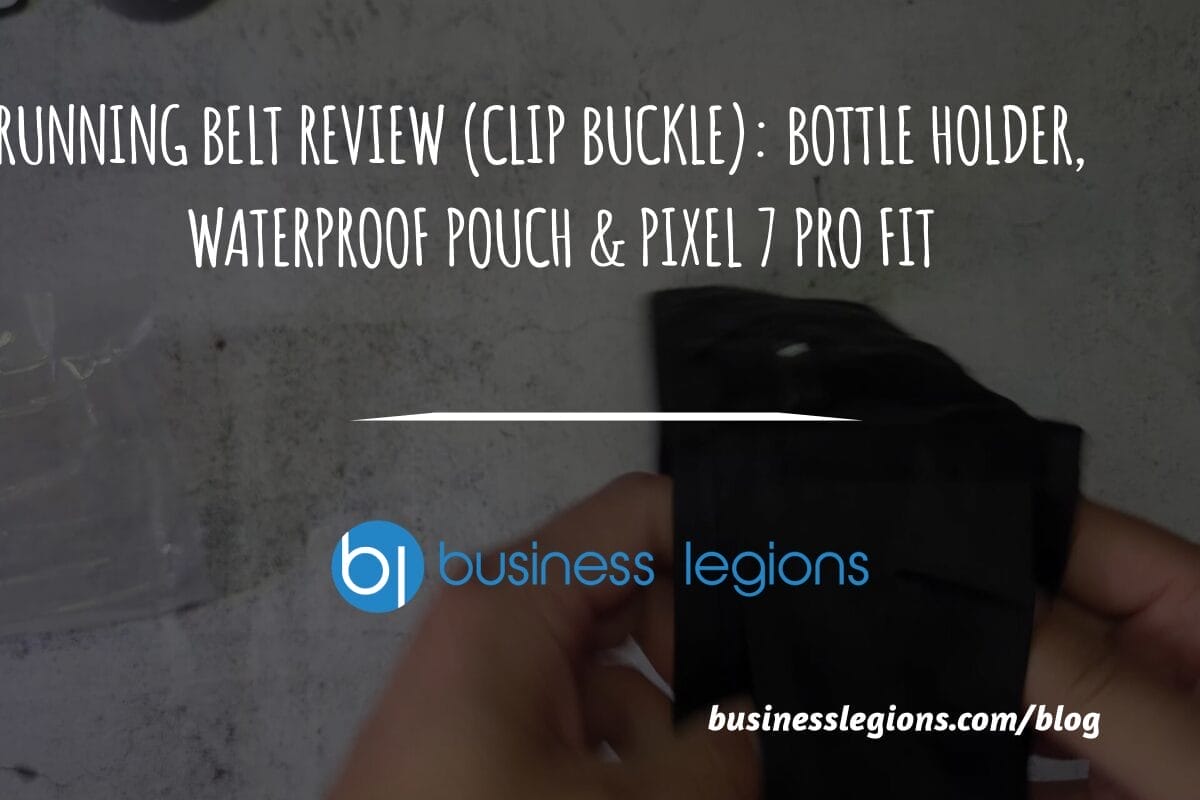
There’s a special kind of anticipation that comes with unboxing fresh kit, especially something as personal as a running belt. It’s the bit of gear that sits closest to you on every run, carrying your phone, keys, gels and—in this case—a water bottle, all while ideally disappearing from your awareness once you’re moving. Today’s subject is a new belt with a clip (buckle) closure. I’ve long favoured velcro belts because they cinch down snugly and, in my experience, bounce less. So I went into this test with a clear preference—and a willingness to be surprised.
At first glance, this belt is a practical, do-it-all design: a main zip pocket roomy enough for a large smartphone, a smaller side pouch that looks perfect for keys, and a dedicated holster for a bottle. The material feels durable and has that slightly rubberised hand that suggests water resistance. It’s very much a “grab-and-go” style: load it up, clip it on, and head out.
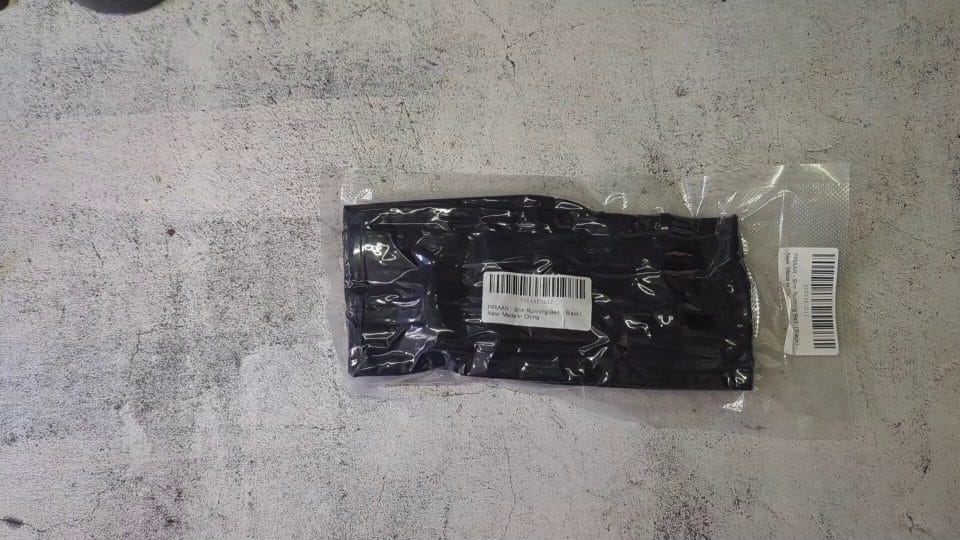
But as every runner knows, the devil is in the details: closures, adjusters, pocket layout, and how everything behaves once you’re actually striding. Below, I’ll break down each feature, share what works, what might need a tweak, and who I think this style of belt will really suit.
Clip vs Velcro: The Battle of the Belt Closures
This belt uses a plastic clip (buckle) to close. It’s a tried-and-true system across backpacks and waist packs: durable, simple, and hard to break. There’s a reassuring “click” when it’s locked in, and it’s easy to operate with cold hands or gloves. If you’re swapping the belt between different layers (summer shorts to winter jackets) or sharing it with a running partner, a clip closure offers quick, repeatable adjustability.
That said, my personal preference, born from many miles, is for a velcro closure. Why? A good velcro belt allows micro-adjustments all the way along the contact area, meaning you can dial in a personalised fit—even mid-run as your layers shift or your stomach expands with water. It hugs the torso smoothly, spreading pressure across the full band rather than concentrating it at a few points. And crucially, with certain designs, velcro belts can eliminate bounce by “sticking” to themselves with very little slack.
Bounce is the nemesis of any running belt. It’s influenced by several factors: how tightly the belt fits, the width and stiffness of the band, where on the torso you wear it (high on the waist vs low on the hips), and the weight you’re carrying. Clip belts rely on a strap-and-slider system. If the webbing is slick or the slider isn’t high-friction, the belt can gradually loosen as you run—especially when you load it with a phone and a bottle. Velcro belts, on the other hand, can maintain a “locked” position across the velcro surface, resisting that incremental slip.
Durability is the counter-argument. Velcro eventually loses bite and can pick up fluff, while plastic buckles can outlast years of road miles. Both systems can work brilliantly; it comes down to the execution—and your tolerance for tinkering. If the clip on this belt holds its adjustment and the material grips clothing, the difference in bounce may be negligible. If not, you can often improve it with simple hacks like an elastic keeper to cinch down the loose tail.
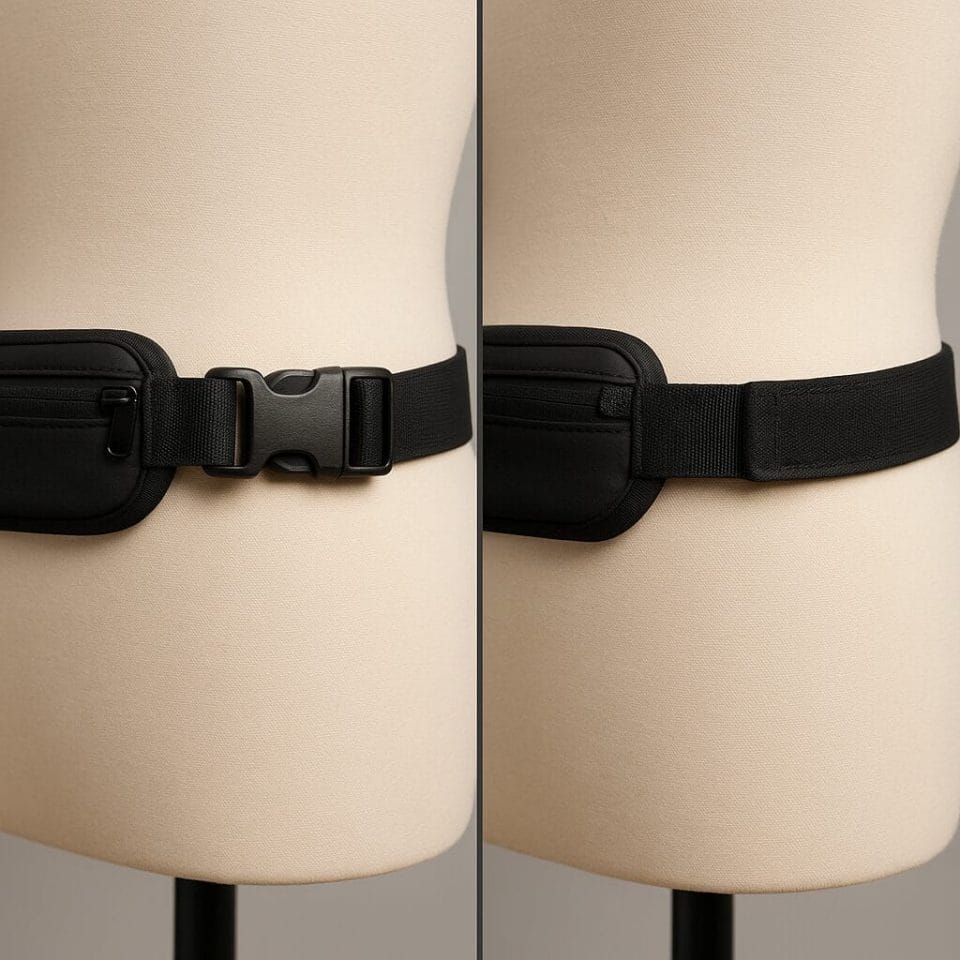
Main Compartment: Big-Phone Friendly and Water-Resistant
The stand-out feature here is the main zip pocket. It’s generously sized—large enough to fit a Google Pixel 7 Pro—so those of us with larger phones won’t be forced to leave our daily driver at home or switch cases. A pocket that swallows a big phone comfortably is more than a convenience: it means you can slide the device in and out without tugging or stretching fabric, which prolongs the life of the zip and the pocket’s seams.
Fitting a Pixel 7 Pro also implies enough volume for a slim case, a bank card, and perhaps an energy gel or a lightweight buff. For many runners, that’s the sweet spot: bare essentials without the need for a vest. When a belt is cramped, you’re forced into awkward packing strategies that cause lumps, pressure points, and more bounce. This one looks to avoid that trap, which is promising.
The material feels water-resistant—slightly rubbery, likely a neoprene blend or coated polyester. That’s good news for British weather. While “waterproof” is often used loosely in marketing, in running-belt land it typically means the fabric itself resists water ingress and road spray, and the pocket will protect your phone from sweat and a light shower. It rarely means submersion-proof. If you’re out in a persistent downpour, consider a mini zip bag or a phone case inside the pocket to be safe.

A quick note on condensation: even with water-resistant fabric, sweat can build up inside if the pocket is not breathable. To minimise moisture, don’t overpack, and try to keep the phone screen facing your body with a thin microfibre wipe behind it to wick any sweat.
Water Resistance vs Waterproof: What to Expect
In practical terms, water-resistant belts do well against drizzle, sweat, and the occasional splash. Waterproof claims are only meaningful if coupled with sealed seams and a water-resistant zip (the kind with a rubberised seal). Most belts use standard zips, which are robust and easier to operate but can let water in under pressure. If you’re often on wet trails or coastal routes, a lightweight zip-lock bag for your phone is an elegant fail-safe that adds minimal weight.
Also consider where you wear the belt. Higher on the waist under a jacket or mid-layer will shield it more effectively. Lower on the hips, over a top, leaves it exposed to rain and spray, especially from the front wheel of a passing cyclist or a puddle splash.
Secondary Storage: The Small Pouch for Keys and Bits
Next to the main pocket, there’s a smaller pouch—ideal for keys. This is a thoughtful inclusion because keys in the main compartment can scratch a phone, jingle distractingly, or create pressure points. A dedicated key pouch allows you to separate metal from glass and pack each item flat. If the pouch includes a tiny key leash (some belts do), even better: you can clip a house key and tuck it inside to eliminate any chance of it working its way out.
Top tip: If your belt doesn’t have a key leash, wrap your key in a small piece of soft cloth or a microfibre wipe. It quietens any noise and stops sharp edges from wearing through fabric over time. Alternatively, use a silicone key cover or even a small elastic band to dull the edges.
There’s also room for a gel, folded £5 note, or a parkrun barcode. Keep heavier items centred in the belt to reduce rotational torque—this reduces the tendency for the belt to twist as you run.
The Bottle Holster: Expandable and Adaptable
This belt features a water bottle pouch that’s distinct from the main pocket. Interestingly, the holster has a zip at the top and the bottom, suggesting it can expand to accommodate bottles of different lengths—a clever touch. It implies a degree of customisability that many belts lack, allowing you to carry a slightly deeper or longer bottle when you need extra fluid, then slim down the holster when you don’t.

If you’re planning to carry water, the question becomes: how much, and how will it affect your run? A small 250–330 ml bottle is often the sweet spot for short-to-medium runs. It adds enough hydration for 30–60 minutes without weighing you down or amplifying bounce. As a rough guide, 500 ml of water weighs half a kilogram—enough to change the belt’s behaviour. If the holster is on one side of the belt rather than centred, that weight can cause slight outward pull and sway.
To manage this, experiment with positioning. Many runners prefer the bottle at the back, centred on the lumbar region, where your body can stabilise the load. Others find wearing it slightly off-centre reduces contact and chafing. The beauty of an expandable holster is that you can fine-tune how snugly the bottle sits. Zip it down for a slim flask; open it up for a deeper one. If you’re using a soft flask, the pouch can compress around it as you drink, which reduces slosh.
In the transcript, there’s a note of caution: “not sure how it is easy to run with… probably a little bit of movement.” That’s honest and fair. Every bottle-in-belt setup introduces some motion, especially at faster paces or on uneven terrain. You can mitigate it by cinching the belt firmer, placing the bottle where your stride causes the least oscillation, or using an elastic retainer loop over the bottle neck for extra security. Some runners also find that carrying the bottle partially full (rather than brim-full) reduces the slosh-induced tug.
Testing with a Smaller Bottle First
If you’re unsure how the holster will handle, start with a small bottle—say 250–300 ml. This is often enough for a 5–10K in mild weather and provides a fair test of bounce without overcommitting. Once you’re confident with the setup, you can step up to a 400–500 ml bottle for longer outings. Observe how the belt behaves at different paces—easy run, tempo, steady hill repeats—and make note of any hotspots or chafing. Sometimes, a 5 mm adjustment in position transforms the experience.
Layout Limitations: No Second Zippered Side for Another Bottle
On the opposite side of the holster, there isn’t another equivalent zip or pocket—so it’s not set up for a second bottle. For many runners, that’s fine. Belts with dual bottles can become bulky and are better suited to specific use cases like long trail runs. But it does mean that on hotter days or on routes without water, you’ll either carry one bottle and plan to refill, stash a small soft flask in the main pocket (if it fits), or opt for a hydration vest instead.
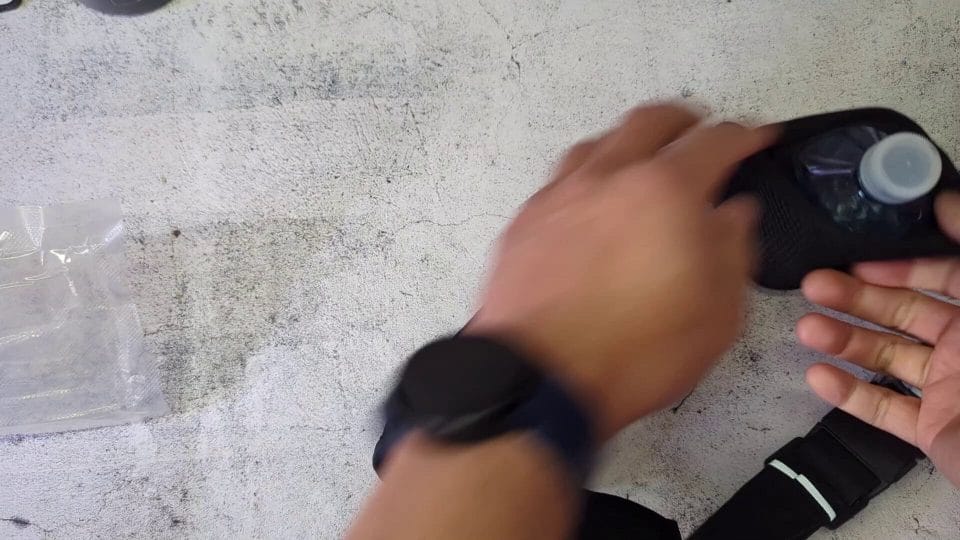
There’s also a balance consideration. A single bottle on one side can introduce asymmetry. Again, this isn’t a deal-breaker, but it underscores the importance of careful packing. Place your heavier items (phone, keys) opposite to counterbalance, or slide the belt so the bottle sits centrally at the back. If the belt doesn’t have symmetrical pockets, it’s worth rotating the whole belt to find the most stable setup for your frame.
The Clip and Adjustment System: Secure, But Initially a Bit Loose
Back to the closure. The belt clips securely, and there’s enough adjustment in the webbing to accommodate various waist sizes. However, the early impression is that when clipped, it feels a bit loose. This can stem from a few things: slippery webbing, a tri-glide adjuster that doesn’t bite firmly, or the elasticity of the belt fabric itself relaxing under load. The comment “you can tie it as well” hints at a pragmatic workaround—tying off the strap tail or adding a half-knot after clipping to maintain tension.
In an ideal world, the adjuster should hold position without fuss. That said, there are easy fixes:
- Add an elastic keeper band to trap the loose tail against the main strap—this reduces creep.
- Double back the webbing through the tri-glide (if the design allows) to increase friction.
- Wear the belt slightly higher on the waist where your torso tapers, which can help it resist downward drift.
Material-wise, it’s “not so bad”—which I’d translate as comfortable enough against the skin with a reasonable balance of structure and stretch. Belts that are too stiff can cut in and chafe; belts that are too soft can roll and slide. The sweet spot is a band that sits flat, flexes with your breathing, and doesn’t dig into the hip bones.
Comfort and Chafing: Little Things Make a Big Difference
Chafing often crops up where seams rub, zips press, or sweat accumulates. A few preventative steps help: wear the belt over a base layer rather than directly on skin, especially in hot weather; position zips away from sensitive areas; and keep the belt snug enough to prevent rub yet not so tight that it restricts breathing. If you’re running in a vest or a pack, remember that the waistband can interact with the belt—stacking two tight bands can lead to pressure spots. Adjust one or the other so they don’t overlap.
Look for soft binding along the belt’s edges and a back panel with a slightly brushed feel. If your belt has silicone gripper dots, they can help anchor it to clothing but may feel tacky on bare skin. In winter, a touch of fabric structure is welcome; in summer, breathable mesh panels make a noticeable difference.
A Sensible Field Test Plan
How to judge this belt fairly? I’d recommend a three-step test:
- Shake-out run (5K): Phone only, light keys in the small pouch. Focus on fit, bounce, and ease of access. Experiment with position—waist vs hips, front vs back.
- Everyday run (8–10K): Add a small 250–300 ml bottle to the holster. Try easy pace, then include a few short strides or a hill to see how the belt behaves at higher intensity.
- Longer outing (12–15K): Increase bottle size or add a gel. Check for cumulative issues: chafing, gradual loosening, pocket ergonomics when you’re sweaty and a bit tired.
On all runs, carry the Pixel 7 Pro in the main compartment as intended to assess zip action, pocket shape, and screen protection. If you run with wired earphones (rare these days, but still), check that the zip path doesn’t kink the cable. With Bluetooth, make sure the phone sits where the signal to your earbuds isn’t obstructed by water or body position—oddly, moving the phone from left to right can sometimes fix intermittent hiccups.
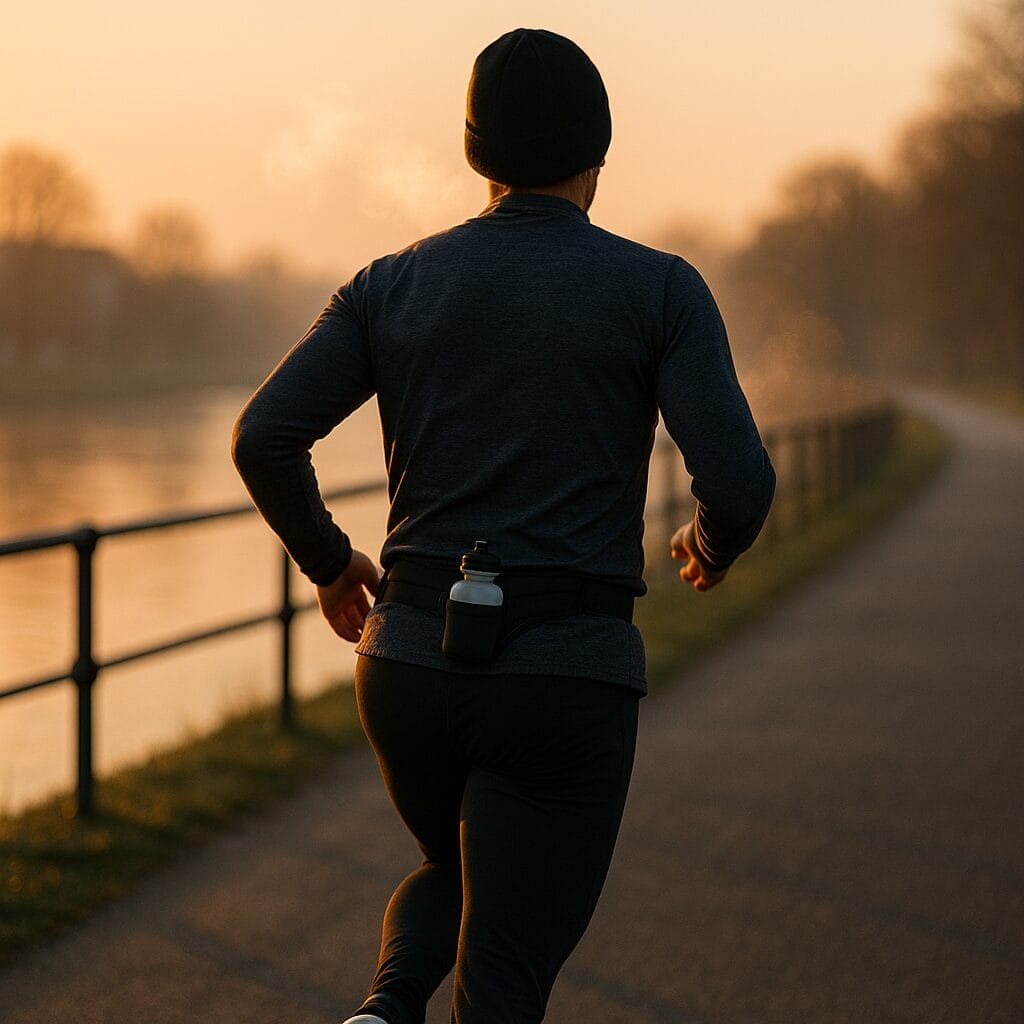
Practical Tricks to Reduce Bounce
If you experience movement, try these practical tweaks before writing the belt off:
-
- Load strategically: Put the heaviest item (usually the phone) in the centre, closest to your spine.
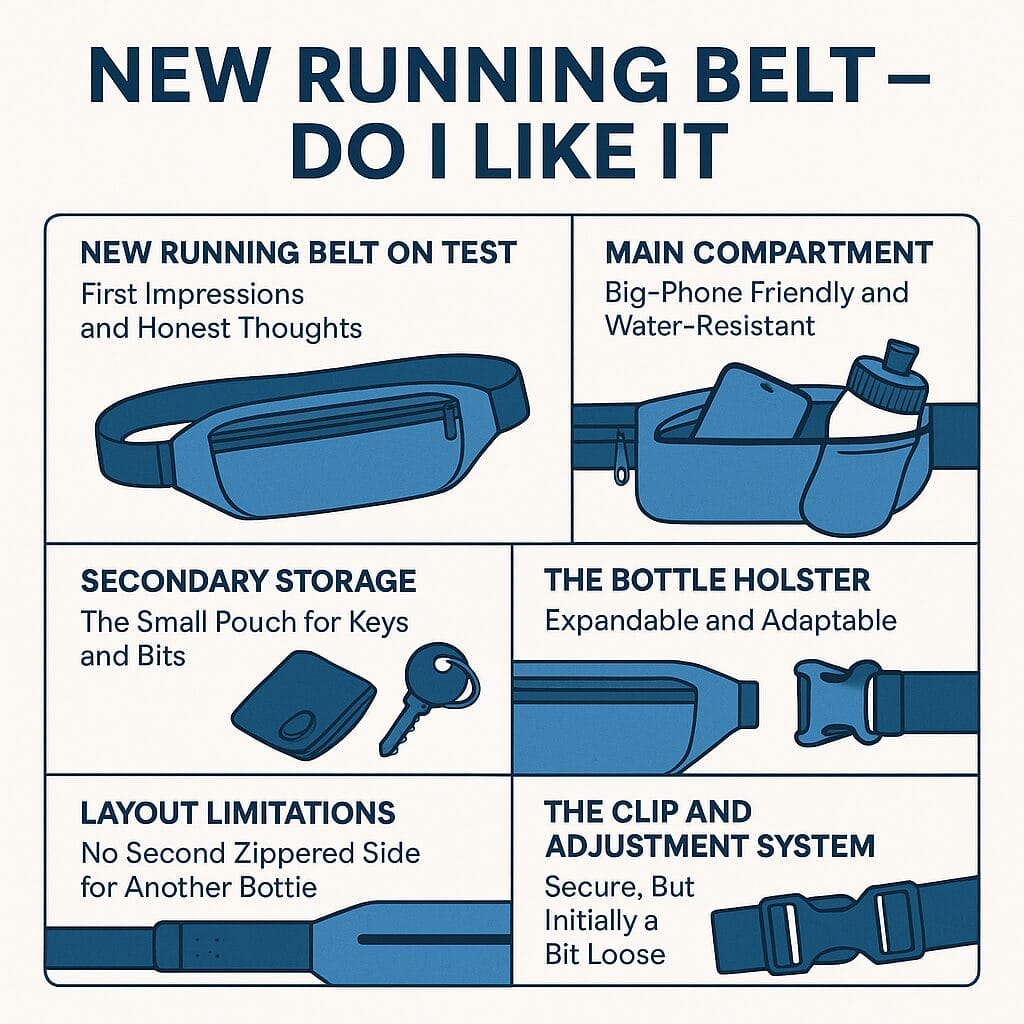
- Angle the belt: Slightly tilt it so the front rides higher and the back sits lower. This can “hook” the belt onto your pelvic shelf.
- Use compression: Wear the belt under a snug top to add friction without extra tightness.
- Shorten the strap tail: Trim excess (if safe) or loop it back under itself to avoid flapping and creep.
- Check bottle fullness: Sometimes 80% full sloshes less than 100% and sits better as you drink.
Also consider your stride. On downhills, any belt will feel livelier. A small change in cadence (slightly quicker steps) can reduce vertical oscillation and thus belt movement. It’s a subtle reminder that gear and technique interact more than we think.
Care and Maintenance: Make It Last
Running belts live a tough life: sweat, rain, sun, and repeated stretching. To keep yours in good condition:
- Rinse after sweaty runs and allow it to air dry fully before storing. Salt crystals can stiffen fabric and abrade stitching over time.
- Hand wash occasionally with mild soap. Avoid harsh detergents and fabric softeners, which can degrade elastic and water-resistant coatings.
- Lubricate zips lightly with a graphite pencil or specialist zip lube if they start to snag.
- Store flat or loosely rolled. Avoid leaving the belt tightly cinched, which can create permanent creases.
If the clip or adjuster begins to slip, consider adding a small piece of rubberised tape to the webbing where it passes through the buckle to increase friction. Simple, low-tech fixes can extend a belt’s life by years.
Who Will This Belt Suit?
Based on the feature set—big phone pocket, small key pouch, and an expandable bottle holster—this belt is a strong choice for everyday runners who want to carry essentials without moving up to a vest. It’s tailor-made for:
- 5–10K road runners who like to carry their phone for safety and tunes.
- Parkrun regulars who need a key and barcode plus a small bottle for warm days.
- Urban runners who appreciate water resistance for changeable weather.
- Commuter runners doing short-to-medium distances where refilling is possible.
If you have a larger phone like the Pixel 7 Pro, this belt’s pocket size alone is a selling point. The water bottle feature adds flexibility—use it when you need it, zip the holster down when you don’t. And if you’re sensitive to belt bounce, there’s enough adjustability to experiment with fit and placement.
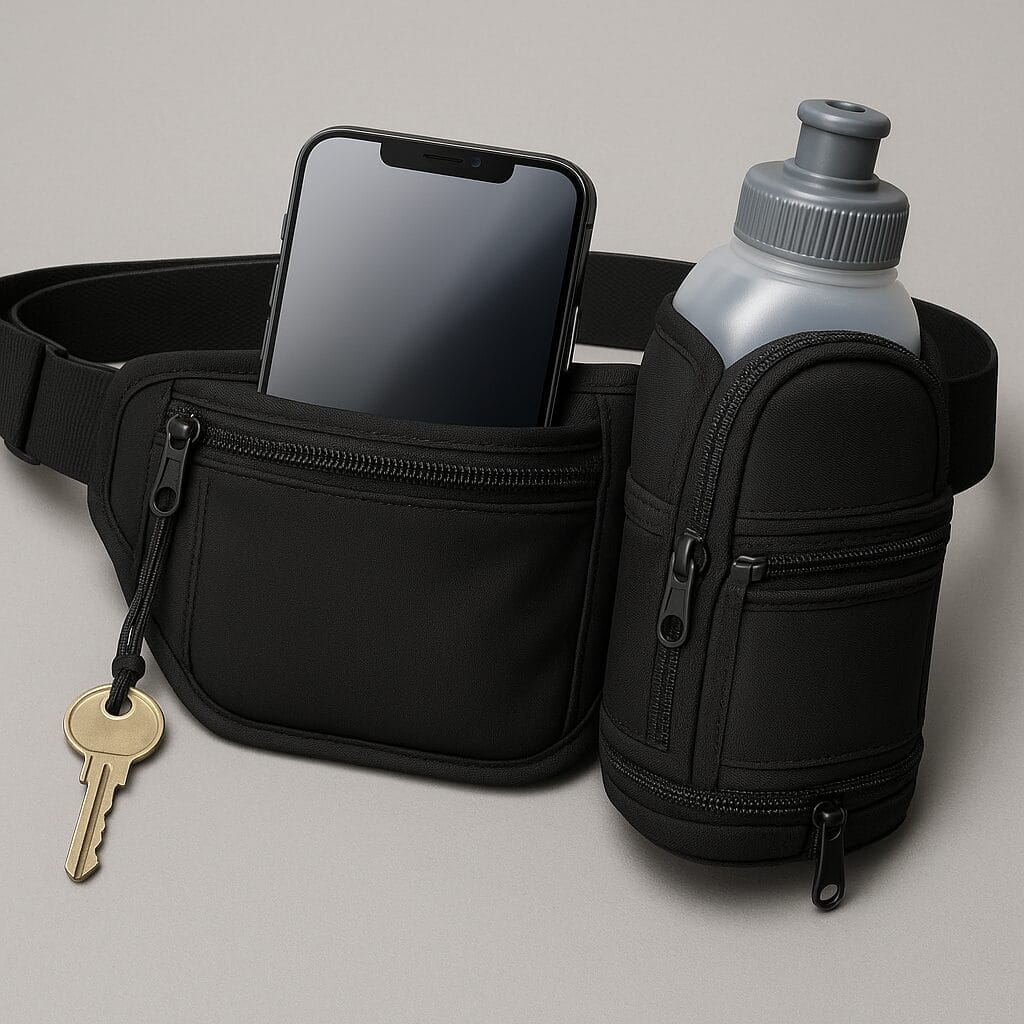
Who Might Prefer Alternatives?
Of course, no single belt suits everyone. You might look elsewhere if:
- You regularly run 90+ minutes in hot conditions and need 1 litre or more of fluid. A hydration vest with two soft flasks or a bladder will distribute weight better.
- You race on trails and want multiple gel pockets, poles, or mandatory kit. A running vest or a modular waist system is more apt.
- You sprint intervals or run very fast paces where any belt movement becomes distracting. A minimalist, all-elastic “flip” style belt or a tighter velcro model might feel more secure.
- You’re allergic to asymmetry. Dual-bottle waist belts exist, though they can be bulkier.
If your top priority is an unshakeable fit with micro-adjustment, a high-quality velcro belt remains hard to beat. But the right clip belt—with good adjusters and the right fabric—can be nearly as stable while offering better durability and ease of use with gloves.
Access and Usability on the Move
One overlooked factor is how easy it is to access pockets mid-run. The main zip should be operable with one hand, and the pull tab ideally is oversized or textured for grip. The bottle holster should allow a smooth draw and re-stow without contortion. If you need to stop to seat the bottle, you’re more likely to hold it for longer than intended, which defeats the purpose of hands-free running.
In practice, rotating the belt slightly to bring the bottle forward can make re-stowing easier, then rotate it back. The expandable zip design could help here: a snug fit is vital for stability, but a half-centimetre more opening at the holster mouth can transform usability without adding bounce. Try the holster zipped down for stability on rough terrain and unzipped a notch for easier access on relaxed road runs.
Reflections on the “Loose When Clipped” Feel
The initial sensation that the belt feels loose once clipped is a red flag for some runners, but it’s worth investigating before concluding it’s a poor fit. Ask:
- Is the webbing slipping through the adjuster? If yes, double back or add an elastic keeper.
- Is the belt riding on smooth fabric (e.g., a winter jacket)? Try underneath a layer for more friction.
- Is the load asymmetric? Rebalance by moving the phone central and the bottle to the back.
- Is the strap too narrow? Narrow straps can dig when tight and feel loose when not. A slightly wider band distributes pressure better.
Sometimes the answer is as simple as sizing down. If you’re at the lower end of the belt’s size range, you may be close to the limits of the adjuster’s holding power. A smaller size places more of the adjustment range in the grippy “sweet spot” of the strap.
Sustainability and Longevity
Running gear needn’t be disposable. Choose a belt you can repair and maintain: replaceable buckles, standard webbing, and robust stitching are all good signs. If you wear through the holster elastic or nick the fabric on a gate, a simple needle-and-thread repair can add years of life. When the elastic eventually softens, belts with structural fabric (rather than relying purely on stretch) tend to maintain function better.
Safety and Visibility
Keep an eye out for reflective trims on belts. They’re small, but they catch headlights at hip height where drivers notice movement. If your belt lacks reflective hits, a stick-on reflective strip is an easy upgrade. Some belts also include bib toggles for pinning race numbers without puncturing tops—handy for race days when you’re swapping layers or wearing a waterproof.
Final Thoughts: Do I Like It?
So, do I like this new clip-closure running belt? There’s a lot going for it. The main pocket is generously sized—big enough to accommodate a Pixel 7 Pro without fuss—and the material feels nicely water-resistant, making it a solid everyday companion in British conditions. The small key pouch is exactly what you want for separating metal from your phone, and the expandable bottle holster is an intelligent touch that broadens the belt’s use cases from quick 5Ks to longer jaunts.
Where I’m cautious is the closure and initial fit. My heart still leans towards velcro for a cinch-and-forget hold that minimises bounce. The clip system here feels slightly loose at first blush, and I’ll be watching closely for any mid-run slippage. That said, it’s not a write-off—far from it. With a couple of simple tweaks (elastic keeper, careful positioning, balancing the load), I suspect it can be made stable enough for most road runs with a small bottle.
In short, if you value a roomy phone pocket and occasional hydration without the heft of a vest, this belt is well worth a try. If you’re ultra-sensitive to bounce or you often carry larger volumes of water, you may prefer a different style—either a high-quality velcro belt or a lightweight vest. I’ll continue to test this one over varied distances and paces, and I’ll report back once I’ve got more miles on it. For now, it’s a promising, practical bit of kit with a couple of quirks—much like many of us runners.
OTHER ARTICLES YOU MAY LIKE

STOP NOISY CALLS: THE ANDROID SETTING YOU SHOULD SWITCH ON TODAY
Phone calls still matter. Whether you’re speaking to a client, checking in with family, or handling something urgent on the move, clarity can make or break the conversation. If you’ve ever found yourself apologising for the construction noise behind you, the wind across your microphone, or the café chatter muddling your words, there’s an Android […]
read more
FILMORA 15 – WHAT’S NEW? AI EXTEND, DYNAMIC CAPTIONS, TRUE TIMELINE EDITING + INSTALL GUIDE
There is a particular thrill to installing a major new release of your everyday editor, especially when your workflow is comfortable and productive in the current version. That feeling is right at the heart of the move from Filmora 14 to Filmora 15. This upgrade promises fresh creative features, faster handling of complex projects, and […]
read more

